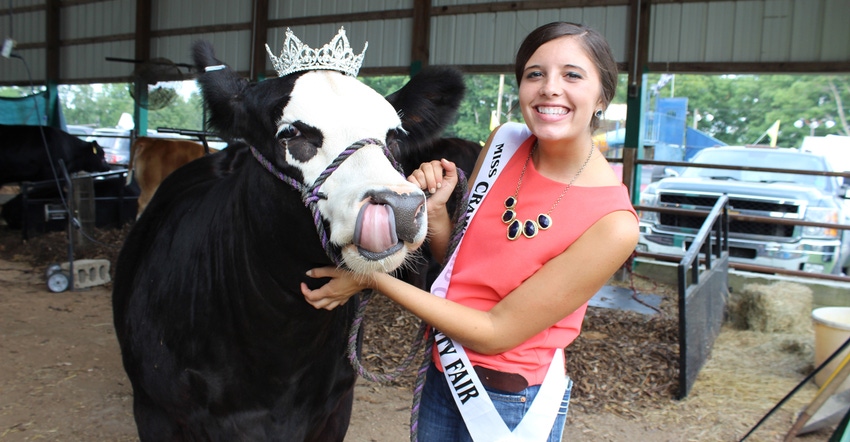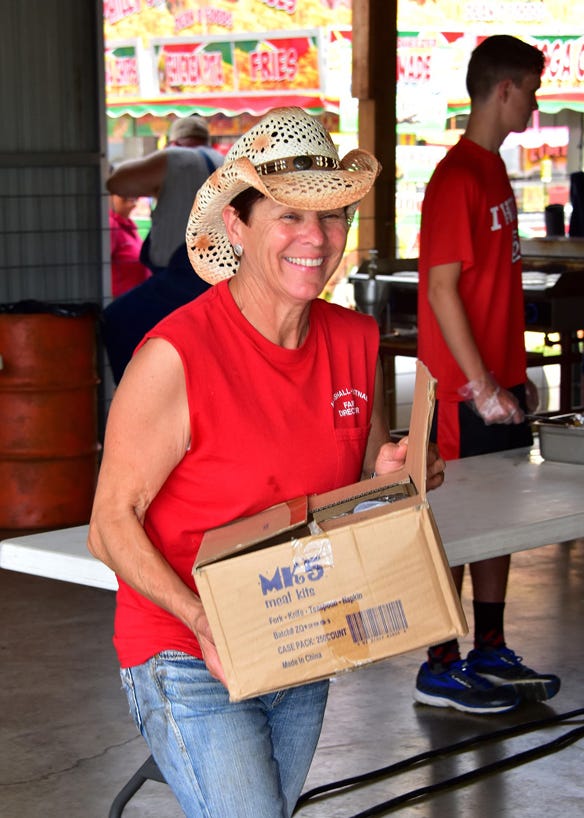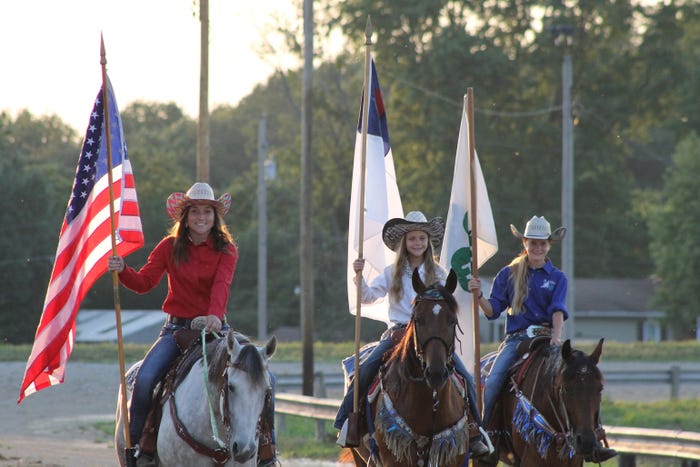
What do county fairs do when state support is down by more than $1 million since 2000 — or nearly 50%?
“We do more with less,” says Dave Hake, past president and current state director of the Illinois Association of Agricultural Fairs southern zone and Washington County Fair director.
“The days of calling a repairman are over with, and we do as much as we can on our own. Almost all the fair boards are stepping up like that,” he explains.
Jim Walsh, IAAF president, says nearly 10% of Illinois’ county fairs face closure. St. Clair County Fair closed in 2015, and the Macon County Fair shut down temporarily in 2014.
“Most county fairs are in survival mode,” says Bill Redshaw, IAAF immediate past president and Schuyler County Fair board member, adding that fairs in southern Illinois are struggling the most. “I know they have to be suffering; there’s no question about it.” He says county fairs “held their own” when state funding was suspended in 2015 and 2018 and delayed in 2016. “Just because it’s in the budget doesn’t mean we’ll get the money.”
“Delays in passage of a state budget, coupled with cash-flow issues from the General Revenue Fund, have impacted all state government funding — including county fair rehab,” says Warren Goetsch, deputy director of the Illinois Department of Agriculture. Gov. Bruce Rauner released rehabilitation dollars for fiscal year 2018 on May 11, just a few weeks shy of the first 2018 Illinois county fair. County fair boards have until June 30, 2018, to submit rehabilitation expense receipts for the preceding fiscal year; then IDOA verifies claims and submits vouchers to the comptroller’s office by mid-August.
“Rehab dollars have been pretty steady for the last six to eight years,” Goetsch says, adding that the 2018 total county fair rehabilitation fund is a little more than $1.3 million. In 2000, the rehab fund was close to $2.7 million.
Katie Pratt, Lee County Fair board secretary, remembers when fairs received $30,000 to $40,000 per year for rehabilitation. For 2018, most fairs will receive about $13,250 per county.
Premium support is also down, Walsh adds, as fairs receive a percentage of a preauthorized base. (See end of story.) Redshaw says several counties use a jackpot system for livestock premiums, and entry fees are split among the winners.
Hake says if the state didn’t release the 2018 premium and rehab funds, several southern Illinois county fairs would likely close. “Some fairs bank on that $13,250 just to pay insurance,” he says.
Money isn’t the only challenge county fairs face in 2018, Hake notes. The Washington County Fair in Nashville competes with big-ticket entertainment venues like Holiday World in Santa Claus, Ind. St. Louis is a short 50-mile drive and home to Six Flags, concerts, Major League Baseball games, museums and more.
Disposable income is a challenge for many families, Hake adds. A night out at the grandstand could cost up to $80 for a family of four, not counting snacks, beverages or souvenirs. “People don’t have the extra cash like they used to,” he says. And when they do spend entertainment funds, not everyone chooses the fair, he adds.
Time is another factor, as families are busier than ever before with traveling sports teams, social activities and parents with demanding careers.
Rising to the challenge
Hake says he won’t let anything happen to the Washington County Fair on his watch. He grew up on the fair circuit, leaving home for the entire summer to show his family’s Holsteins. Last year was the first time in 70 years that his family didn’t show cattle at the fair.
“Fairs are dear to my heart,” he says. “I wouldn’t keep doing this if they weren’t.” The Washington County Fair offered private and corporate sponsorship opportunities for the first time this year. Sponsors received grandstand passes and their logo on promotional materials, such as programs, banners and T-shirts.

MAKING IT HAPPEN: JoVonna Kocher, Marshall-Putnam County Fair board director, has served on the board since 1985. Bill Redshaw, former IAAF president and Schuyler County Fair board member, says county fairs wouldn’t be possible without volunteers. “I know [fairs] have to be suffering; there’s no question about it,” he says. “They’re just doing the best they can.”

The Lee County Fair also accepts private donations and sponsorships. “We’ve really stepped up our game in terms of fundraising,” Pratt says. “We had to.” Lee County farmers may donate grain to the Bushels to Blue Ribbons campaign during harvest, which raises from $1,000 to $6,000 per year.
Several counties find ways to use the fairgrounds all year. Lee County rents out the exhibit hall for weddings, reunions and meetings, while the Washington and Schuyler county fairs offer storage space for campers and RVs.
Todd VerHeecke, Henry County Fair board, says extensive renovation projects, such as new cattle or hog barns and roof repairs, wouldn’t be possible without financial support from local businesses and foundations, private contributions, and the fair board members who donate their time and resources. “We’re extremely fortunate to have support from local businesses and families,” he says. “There are many people in Henry County who want to see the fair not just survive, but thrive for future generations.”
Finding the sweet spot
When it comes to keeping county fairs viable, there’s no one-size-fits-all solution. To boost attendance in Henry County, VerHeecke says the board books big grandstand shows each night, like concerts, tractor pulls, demolition derbies and figure-8 races.
“It seems like it’s harder and harder to get folks there, so we make sure we provide some good entertainment for folks to come out,” VerHeecke says.
Hake says a big concert or show may not be the answer for every county fair.
“What works at one county won’t work at the county next to it,” he notes, adding that southern Illinois counties lack the population to support big concerts or events like northern counties may host.
In Nashville, Hake says the board is trying new things, like offering free open-class entries, while keeping their traditional grandstand events, like a rodeo and demolition derby. “We make the best of what we can do,” he says.
“In today’s world with technology and the availability of entertainment, some county fairs struggle to remain relevant,” Goetsch says. “I do believe that the successful county fairs find their niche.” The fairs that combine agriculture, a sense of community and “the past and future” will thrive, he adds. “They must find that sweet spot.”
 TRADITIONS: The Edwards County Fair kicks off fair week with a Vespers service. Flag carriers are Brooklyn Hazel with the American flag, Lola Nussmeyer with the Christian flag and Lillian Nussmeyer with the 4-H flag.
TRADITIONS: The Edwards County Fair kicks off fair week with a Vespers service. Flag carriers are Brooklyn Hazel with the American flag, Lola Nussmeyer with the Christian flag and Lillian Nussmeyer with the 4-H flag.

How did the Lee County Fair find the right mix? The board stopped comparing the fair to neighboring counties and stayed true to their 4-H roots, Pratt says.
“It took us years of reminding ourselves that we’re us. We need to do us,” she says. “Our mission has always been all about our kids and 4-H members.”
The Lee County Fair schedule is filled with 4-H projects judging, livestock shows, pedal pulls and more, all geared toward youth. “4-H’er or not, we want kids and their families to have a great time when they come to the Lee County Fair,” Pratt says.
As the 2018 county fair season kicks off, board members and volunteers roll up their sleeves for another year of hard work.
“It’s all about the people,” Pratt says. “You need the right people in the right place, and that’s when the magic happens.”
County fair premium breakdown
IDOA reimburses each eligible county fair as follows:
* 100% of the first $2,000 of approved premiums awarded
* 85% of the next $2,000
* 75% of the next $3,000
* 65% of the next $3,000
* 55% of the next $4,000
* 50% of the remaining premiums paid until the total reimbursement equals the authorized base amount for each fair
A fair’s authorized base is determined by the highest premium expenditure over a two-year period. If a county fair spends $5,000 in year one and $10,000 in year two, the authorized base is calculated from the premium expenditures in year two and multiplied by 66.6%. The challenge? If the authorized base for all counties exceeds IDOA’s total appropriation for awards and premiums, fairs receive an equal prorated amount that may be less than the county’s authorized base. For a list of recent premium payments, check out the 2017 recapitulations report on the IDOA website.
About the Author(s)
You May Also Like




